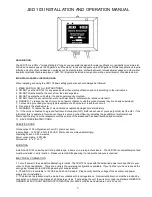
Silver Direct Locomotive decoder
4
4
The constant braking distance does not function in analogue DC mode.
Mapping function outputs
Using function mapping (CVs 33-46) you can define which functions of the digital
system are used to control the A, B, C and D function outputs. The outputs A, B and C
can be allocated to function F0 (direction-dependent) or functions F1 to F8 as desired.
Output D can be allocated to function F0 (direction-dependent) or functions F1 to F12
as desired.
Lighting effect at function outputs
Special lighting effects can be assigned to each of the function outputs. The lighting
effects for the function outputs A and B are set in CV60 and for the function outputs C
and D in CV62. If you wish to switch the effects with a function of the digital system,
you can make the allocations to functions F1 to F8 in CV61 (for function outputs A and
B) and CV64 (for function outputs C and D). The effects available are shown in the CV
table defined later in this manual.
Asymmetrical DCC = Automatic Braking Control
simple signal stop and slow approach
You can carry out a particularly simple stop at a signal using the ABC braking module.
Depending on the signal position, this module creates an asymmetric track voltage in
the braking section in front of the signal. The decoder reacts to this. Combined with the
constant braking distance, precise on-the-spot stopping in front of red signals is not a
problem. Of course, passage in the opposite direction is also possible. The signal
indication "slow approach/caution" can be set using CV53.
You can operate all functions during the signal stop or slow approach – you can even
reverse away again from the red signal! These special ABC modules can be used to
assemble a very simple block section.
Activate the ABC control by setting Bit 2 (1) in CV51.
Push-pull train control
A push-pull train control can be set if the ABC braking module is used. There are two
different options: push-pull operation with and without intermediate stops. The latter
also takes slow-approach sections into account.
The push-pull train control is activated in CV51, Bit 4 (3) and Bit 5 (4). The stopping
time at the end of the track is set in CV54 (1 to 255 sec).
Preparing to Install the SILVER decoder
A locomotive that runs well under DC will run exceptionally well under DCC. Replace
worn out motor brushes and burned out light bulbs. Clean any dirt or oxidation from the
wheels and pickups, and make sure that electrical contact is good. Now is also a good
time to lubricate your locomotive.































